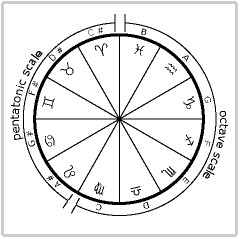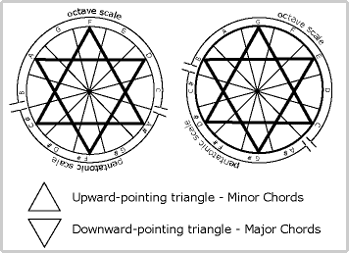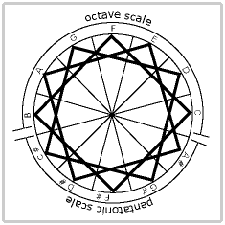|
The
Classical Music of the Twenty-First Century
by Don
Robertson
© 2000 by Don Robertson
<
Previous Page
Next Page >
The Duochord
As I struggled with the creation of my Last Piece, I
also reflected upon the great difference between the music
that I was creating with Morty, and the music that I was
playing with Khansahib. One day I was reading a book by
Corinne Heline about music and its spiritual effects when I
noticed that there was a diagram in the book that explained
how the twelve notes of the musical chromatic scale
corresponded with the twelve signs of the astrological zodiac.
At that time I was interested in astrology and I thought this
was an interesting concept. The way she explained it, the
notes were placed counter-clockwise on the circle of the zodiac as follows: C, D, E,
F, G, A, B, C#, D#, F#, G#, A#. I don’t know where she
learned this, but it was very interesting. It was the 7-note
major scale (the white keys of the keyboard), followed by the
5-note pentatonic scale (the black keys of the keyboard): the
two most powerful scales in the music.

I was fascinated by this discovery. Astrology is based on a
circle, around which are drawn the 12 astrological signs.
Positive and negative relationships in astrology are
determined by where one sign stands in relationship to
another. I began to wonder that if this was the case in
astrology, wasn’t it also the case for the twelve notes of
the musical chromatic scale (the chromatic scale in music
includes all the black and white keys of an octave).
With this in mind, I drew astrological trines in a
circle that had Corinne Heline’s note values assigned to it.
The trines, or triangles, define the most positive
relationships between the signs: harmony and concord. To my
surprise, applying the trines to my drawing not only yielded
the most positive relationships between the signs, but also
the most positive relationships between musical notes: the
major and minor triads. The four triangles created two major
triads and two minor triads on the circle! This showed me that
by assigning the notes to the circle as she had described, the
overlaying of triangles yielded the very foundational elements
of music itself: the major and minor triad!

After marveling at this for a while, it came to me to draw squares.
In astrology, squares represent the negative elements: discord
and lack of harmony. So I drew the three possible squares. I
looked at what ensued and was completely shocked! There before
my eyes I saw the very chords that were the foundation of the
music that I had been composing. Each square was a four-note
chord made up of two half tones separated by a tritone:

Whether you believe in astrology or not is unimportant.
Here we are dealing with mathematics and symbolism. They are
important because they give insights into the inner workings
of nature. And I realized that I was looking at a mathematical
representation of the very conflict that I was beginning to
feel emotionally in my life: the music that I was composing
with Morty on one hand, and the music that I was playing with
Khansahib on the other. One was based on the triangles, the
other on the squares. With Morty, I was composing music that
was completely negative!
That realization bothered me a great deal, and I
contemplated it for months. I loved my duochordal music, and
if what I was beginning to understand was indeed true, I would
have to abandon it, because I knew in my heart that I did not
want to create something that was negative.
Finally, I decided to speak with Morty. I told him that I
had a conflict developing within me. He listened carefully as
I asked him:
"Do you think that this music that you and I write is…,"
I stumbled for a tasteful word to use, "…unnatural?"
He answered me immediately, without any reflection, and his
answer surprised me. He said:
"Yes, it is unnatural, but if you ever quote me on
that, I will deny that I ever said it."
I realized that this was to be our last lesson. The two
years of weekly visits would be over. I was sad, but I knew it
had to be.
That summer, I moved away from New York, following
Khansahib to the San Francisco area where he was establishing
a school for North Indian classical music. In San Francisco, I
recorded my album Dawn. This was the album that
reflected my struggle between the two shades of music, light
and dark…a struggle that would soon be played out on my last
battlefield. After the album was completed, my wife and I left
San Francisco for a six-month stay in Mexico and Guatemala.
There I would perhaps find my way, purify myself, and maybe
find a true spiritual path.
For months I struggled within because there was still a
part of me that had a strong desire to write duochordal music.
But one night, in a dream, I heard a duochord composition
being played that consisted of a succession of one negative
chord constructed of disharmonious intervals succeeded by
another, then another, and so on. The music was being played
very loudly by a very powerful brass ensemble! Every time one
of the loud chords sounded, it sent a cold shiver up my back
and I felt a wave of darkness flow over me. I awoke in a state
of panic and terrifying fear. I knew at once that I had to
completely let go of my desire to compose and enjoy duochordal
music. But it took nearly a half a year south of the border to
free myself from the grip of negative music.
(Click HERE
for an example of duochordal music)
<
Previous Page
Next Page >
|

